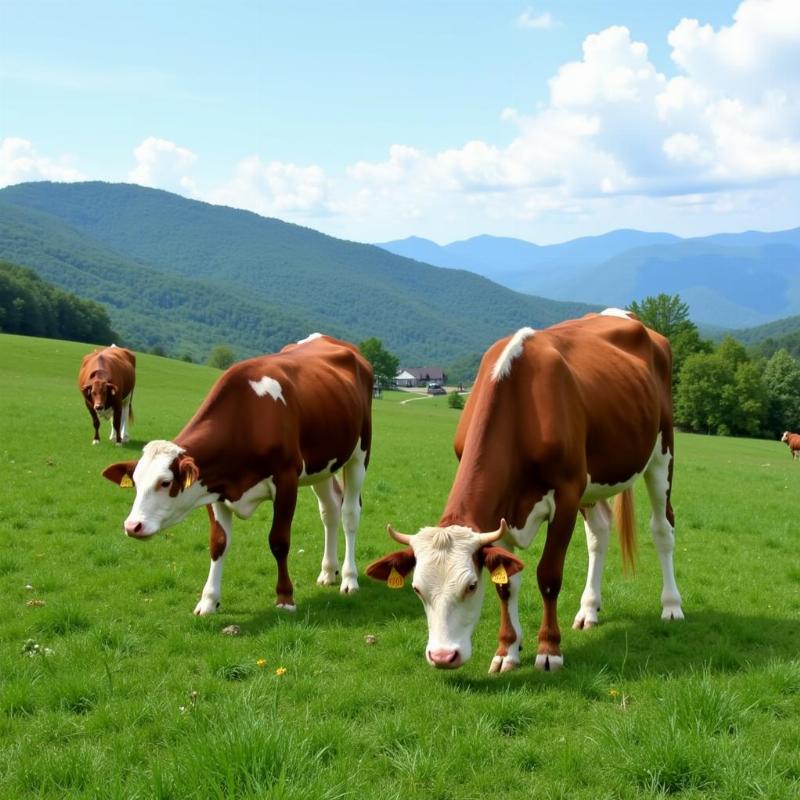Blue ridge beef for dogs has become a popular topic amongst pet owners seeking high-quality protein sources for their canine companions. But is it really all it’s cracked up to be? This article will delve into the potential benefits and drawbacks of feeding your dog blue ridge beef, examining its nutritional value, sourcing practices, and potential impact on your dog’s overall health. We’ll explore whether this protein source is a suitable addition to your furry friend’s diet, taking into consideration American Kennel Club guidelines and current veterinary recommendations.
Understanding the Appeal of Blue Ridge Beef
Blue ridge beef often evokes images of cattle grazing on lush pastures in the picturesque Blue Ridge Mountains. This idyllic picture appeals to pet owners looking for natural, wholesome food sources for their dogs. Many believe that this beef offers superior quality and flavor compared to conventional beef products. But what exactly makes blue ridge beef different, and does this difference translate into tangible health benefits for your dog? Let’s explore the factors contributing to its perceived appeal. One key aspect is the focus on sustainable farming practices, often associated with smaller, local farms.
 Blue Ridge Cattle Grazing
Blue Ridge Cattle Grazing
Nutritional Profile of Blue Ridge Beef
Beef, in general, is a good source of protein, which is essential for building and repairing tissues, supporting a healthy immune system, and providing energy. It also contains essential amino acids, vitamins, and minerals like iron and zinc. However, the specific nutritional content of blue ridge beef can vary based on the cattle’s diet and farming practices. Is it significantly more nutritious than beef from other regions? While the picturesque environment might suggest a healthier product, concrete nutritional data is crucial to determining its true value.
Sourcing and Sustainability: Key Considerations
The sourcing of blue ridge beef is a crucial factor in determining its quality and impact. Look for producers who prioritize sustainable farming practices, such as rotational grazing, which benefits both the animals and the environment. Supporting local farmers also contributes to the local economy and often allows for greater transparency regarding the cattle’s upbringing and diet. Are there certifications or labels to look for that guarantee responsible sourcing and sustainable practices? Understanding these factors empowers pet owners to make informed choices that align with their values and prioritize their dog’s well-being.
Potential Benefits and Risks of Feeding Blue Ridge Beef
While blue ridge beef can be a nutritious addition to a balanced canine diet, it’s essential to consider potential risks and introduce it gradually. Some dogs may have sensitivities or allergies to beef. Always consult with your veterinarian before making significant changes to your dog’s diet. They can help you determine the appropriate portion size and assess whether blue ridge beef is a suitable choice based on your dog’s individual needs and health condition. What are the signs of a beef allergy in dogs, and how should these be addressed?
Incorporating Blue Ridge Beef into Your Dog’s Diet
If your veterinarian gives the green light, start by introducing small amounts of cooked blue ridge beef to your dog’s regular food. Observe for any signs of digestive upset or allergic reactions. If your dog tolerates it well, you can gradually increase the amount. Remember that a balanced diet is key, so ensure that blue ridge beef is part of a complete and nutritious meal plan, rather than the sole source of protein. How can Blue Ridge Beef be incorporated into a raw food diet for dogs?
Conclusion
Blue ridge beef can be a valuable protein source for dogs, offering potential benefits associated with its natural sourcing and focus on sustainable farming. However, it’s crucial to research the specific source, consider your dog’s individual needs, and consult with your veterinarian before incorporating it into their diet. By understanding the nutritional profile, sourcing practices, and potential risks, you can make an informed decision about whether blue ridge beef is the right choice for your furry friend.
FAQ
- Is blue ridge beef healthier than regular beef for dogs? The health benefits depend largely on the farming practices. Look for sustainably raised beef.
- How can I find reputable sources of blue ridge beef for my dog? Research local farms and look for certifications that indicate sustainable practices.
- Can puppies eat blue ridge beef? Consult your vet before introducing any new foods to a puppy’s diet.
- What are the signs of a beef allergy in dogs? Common signs include skin irritation, digestive upset, and ear infections.
- How much blue ridge beef should I feed my dog? Portion sizes depend on your dog’s size, age, and activity level. Consult your veterinarian.
- Can I feed my dog raw blue ridge beef? While some pet owners choose raw diets, there are risks associated with raw meat. Discuss this with your vet.
- Is blue ridge beef more expensive than other beef options? It can be, due to the specialized farming practices often employed.
Beautdogs.us is your premier online destination for comprehensive dog care information, breed insights, and product recommendations. Whether you’re a new dog owner or a seasoned expert, Beautdogs.us offers expert advice, valuable resources, and a supportive community to help you navigate the joys and challenges of dog ownership. From breed-specific guides to nutritional advice and training tips, we are committed to providing reliable information to enhance the well-being of your canine companion. Connect with us for personalized support: Email: [email protected], Phone: +1 501-555-7529. Visit Beautdogs.us today to empower your journey as a responsible and informed dog owner.